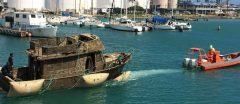Swell on the Way
Hawaiian Airlines Hana Hou Inflight Magazine
From marine construction to undersea robotics, many project timelines are dictated by ocean conditions. The staff at Sea Engineering, a company started by the University of Hawai‘i’s first ocean engineering grad students, is constantly planning their work—building jetties, replenishing beaches, salvaging wrecks, repairing seawalls and installing undersea cables and pipelines—around wave forecasts.
Sea Engineering also models sea level rise, providing technical information to businesses and government agencies that must make tough, costly decisions. Looking into the future, wave inundation and wave action will have larger implications for Hawai‘i’s dynamic coastlines, explains SEI project manager and coastal geologist Chris Conger. “People intuitively understand that waves and beaches are related but perhaps don’t understand just how linear that relationship is,” Conger says. “Sand doesn’t just move on its own. You have to have energy, and that energy is brought to shore through waves—by wave uprush, downrush or the longshore currents they create. As water level changes, wave energy increases exponentially, and it also changes how the waves are refracting and reflecting along the shoreline.”












